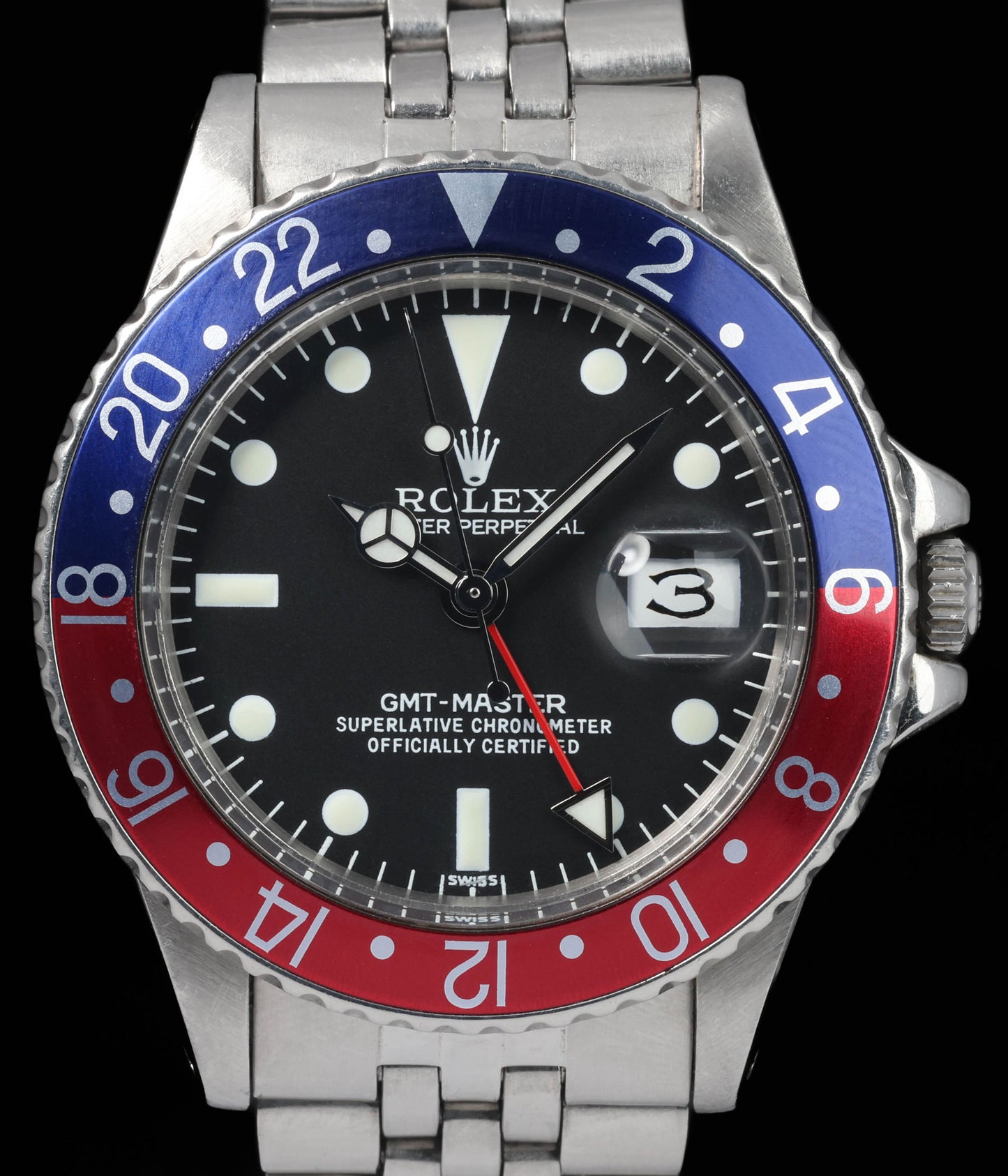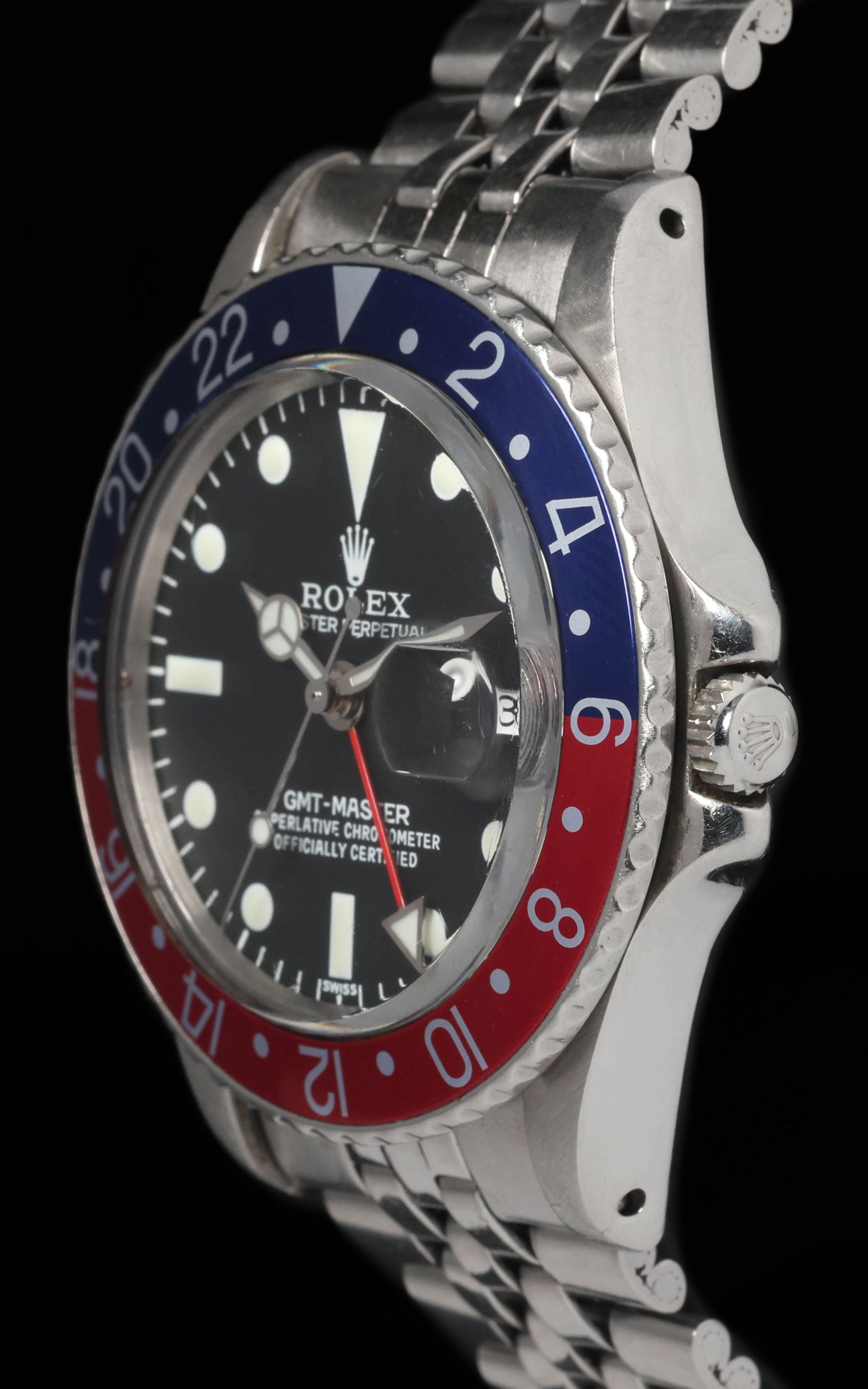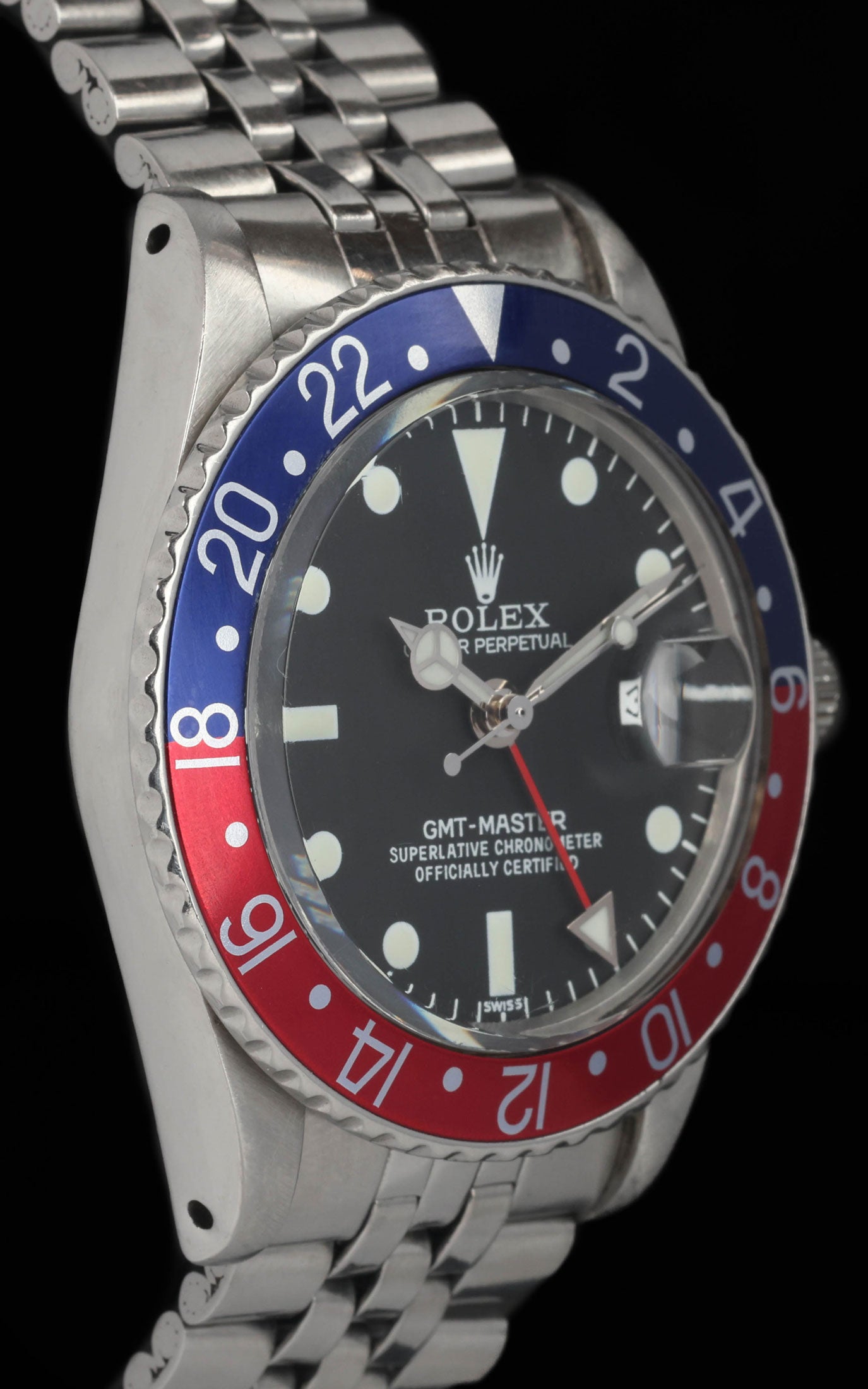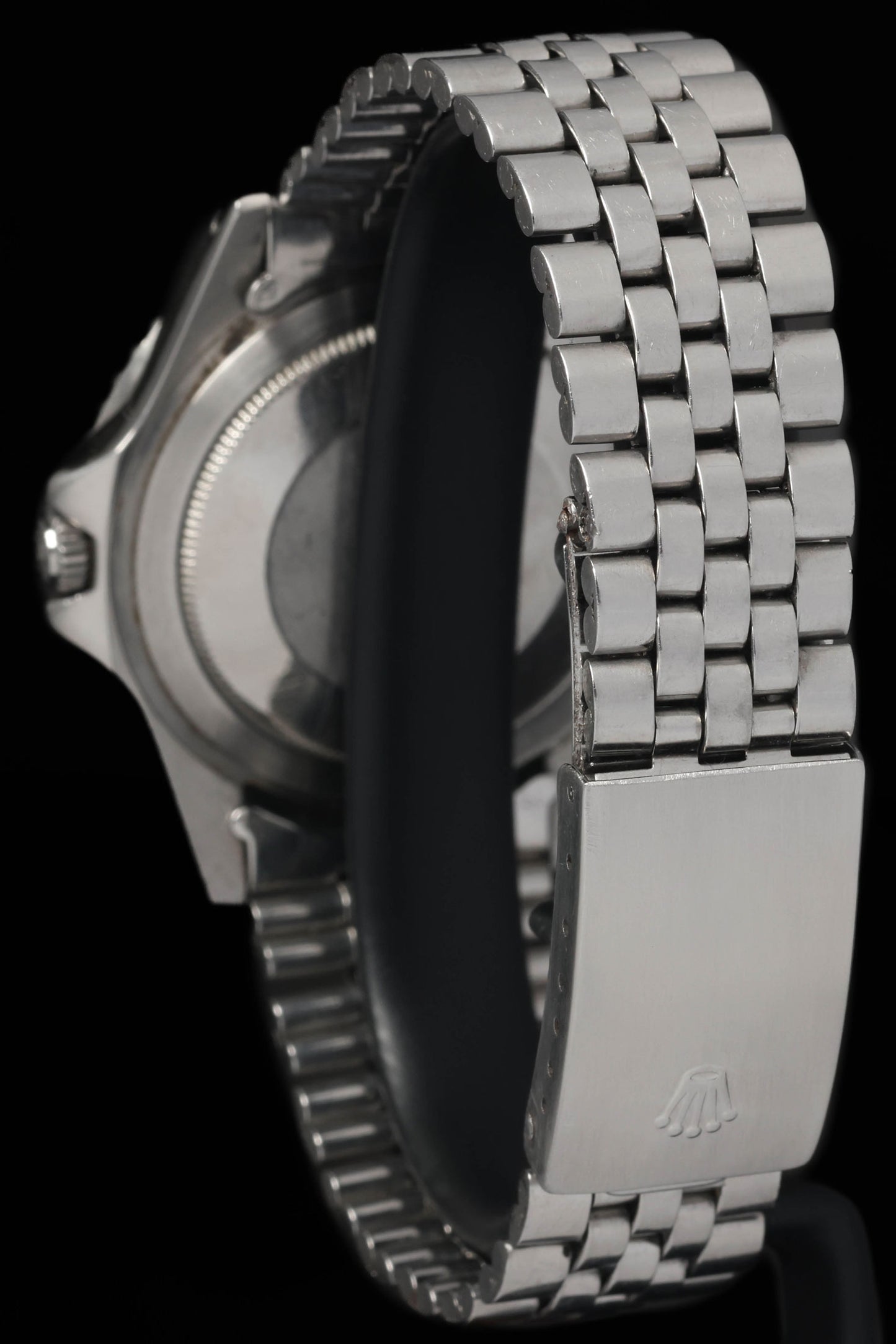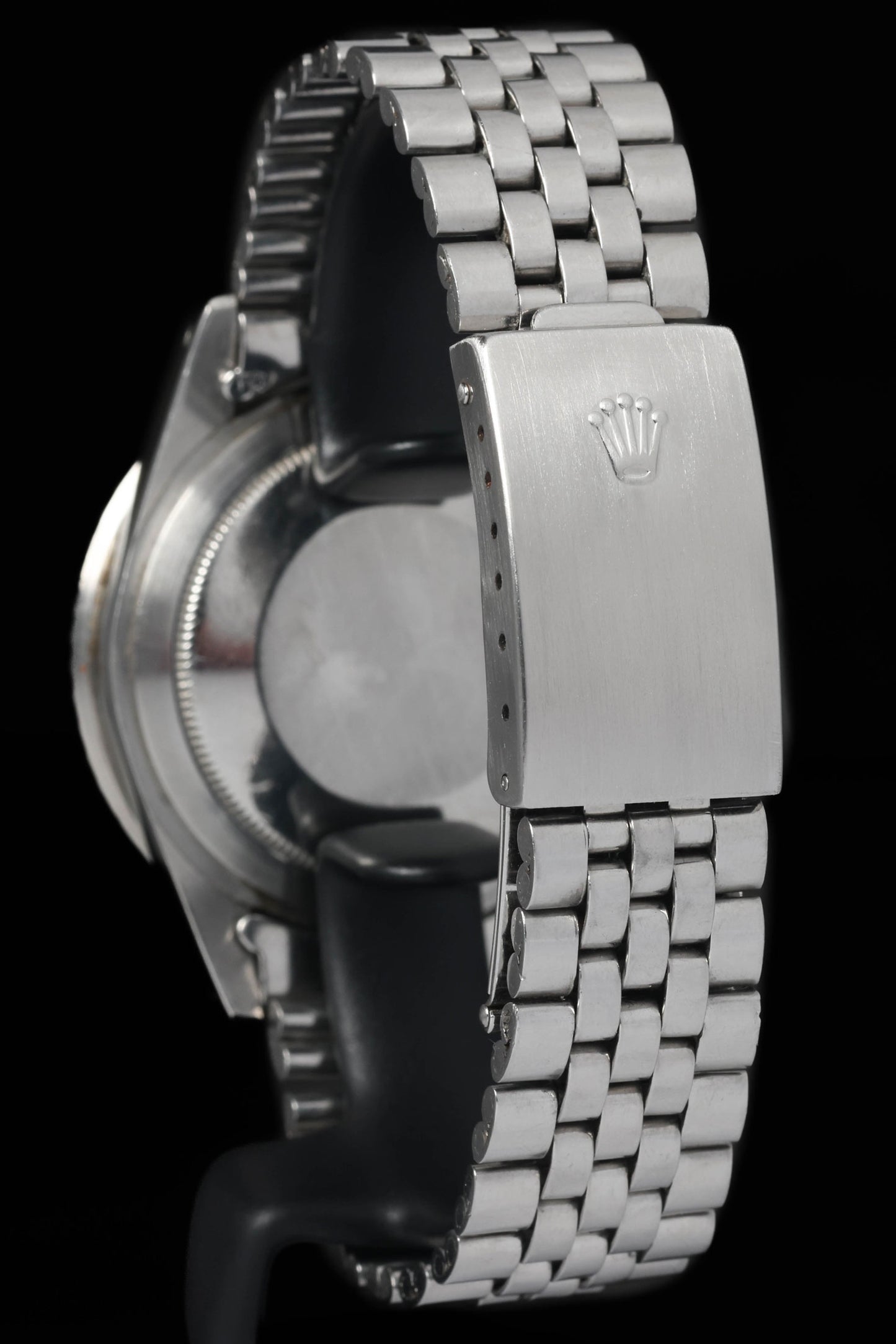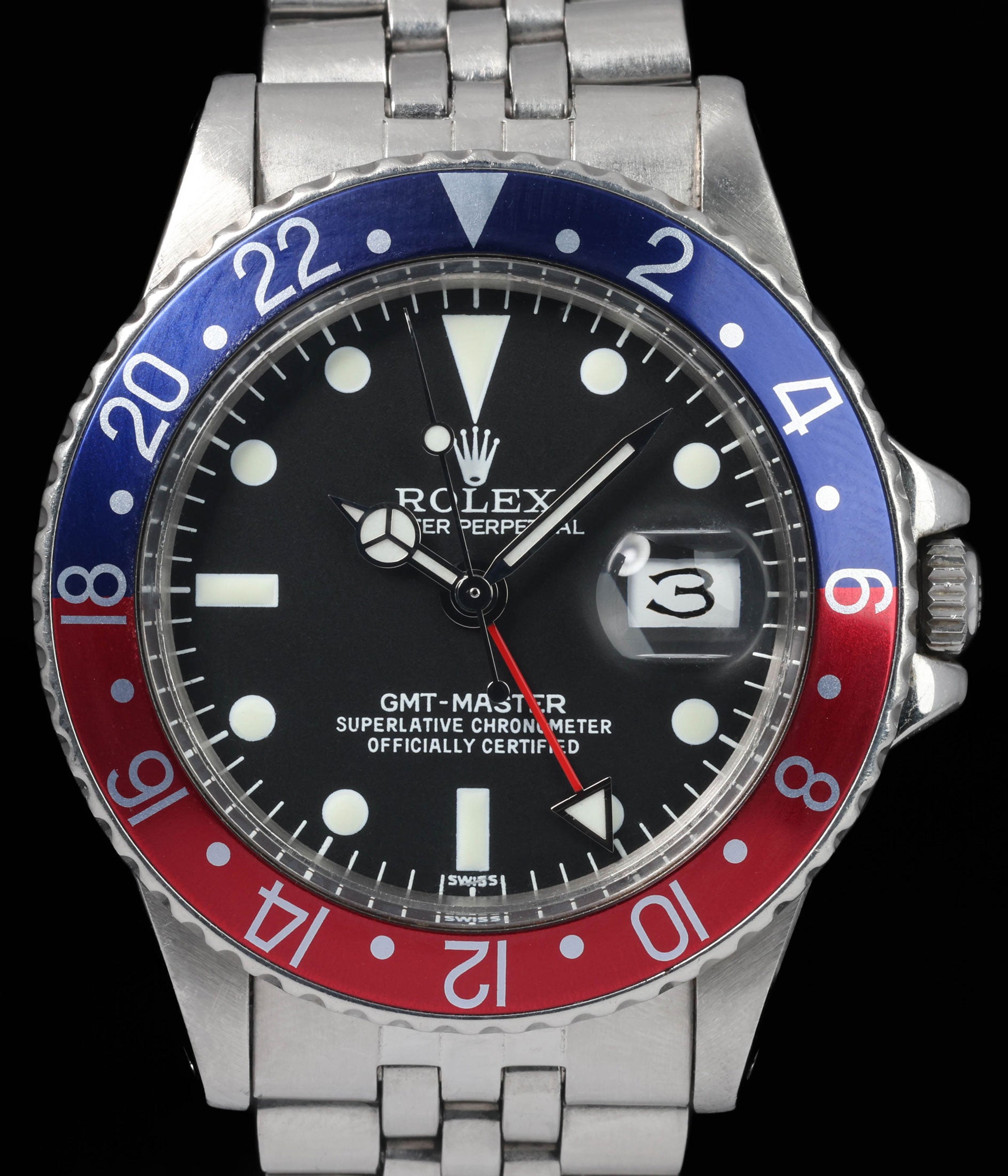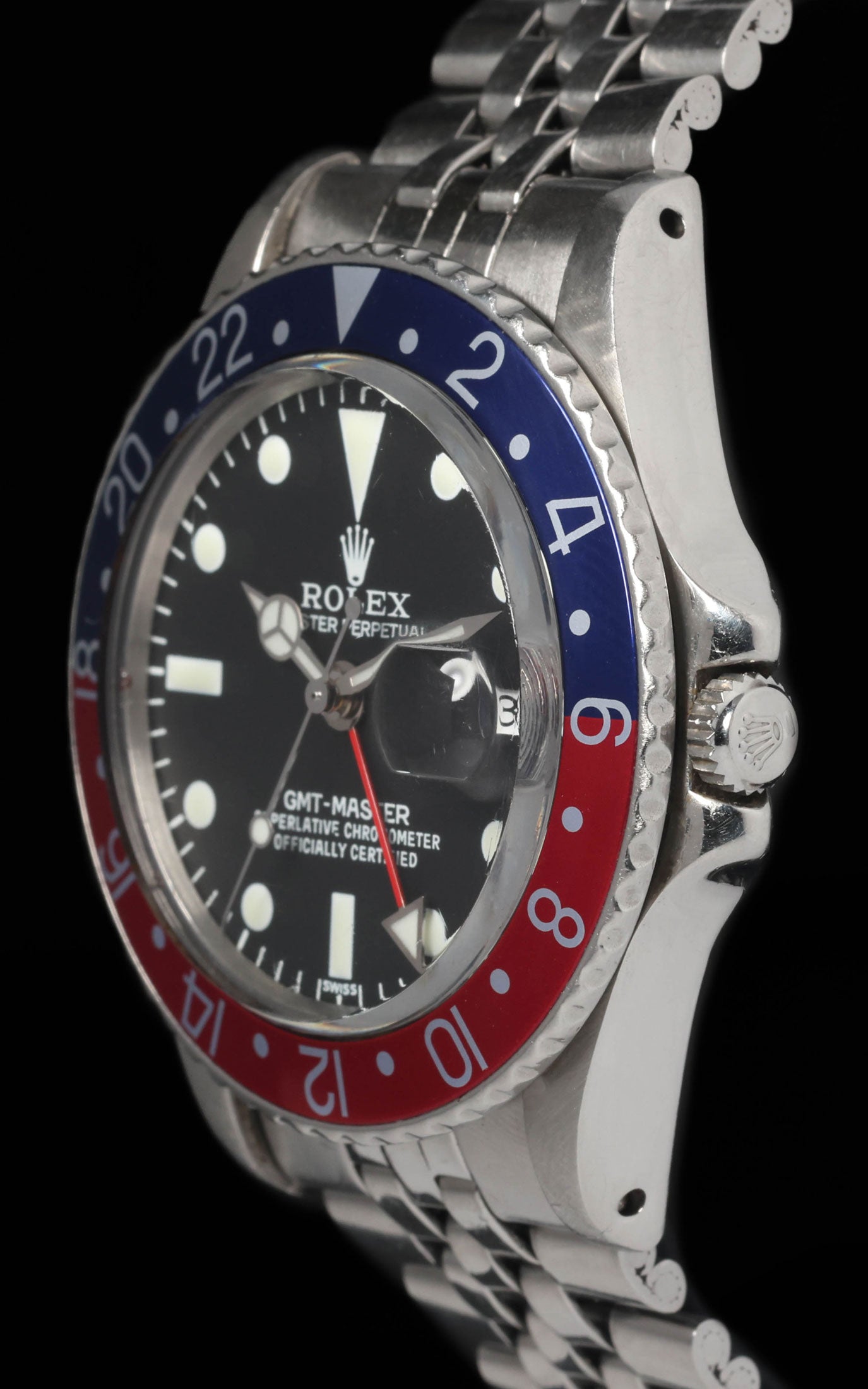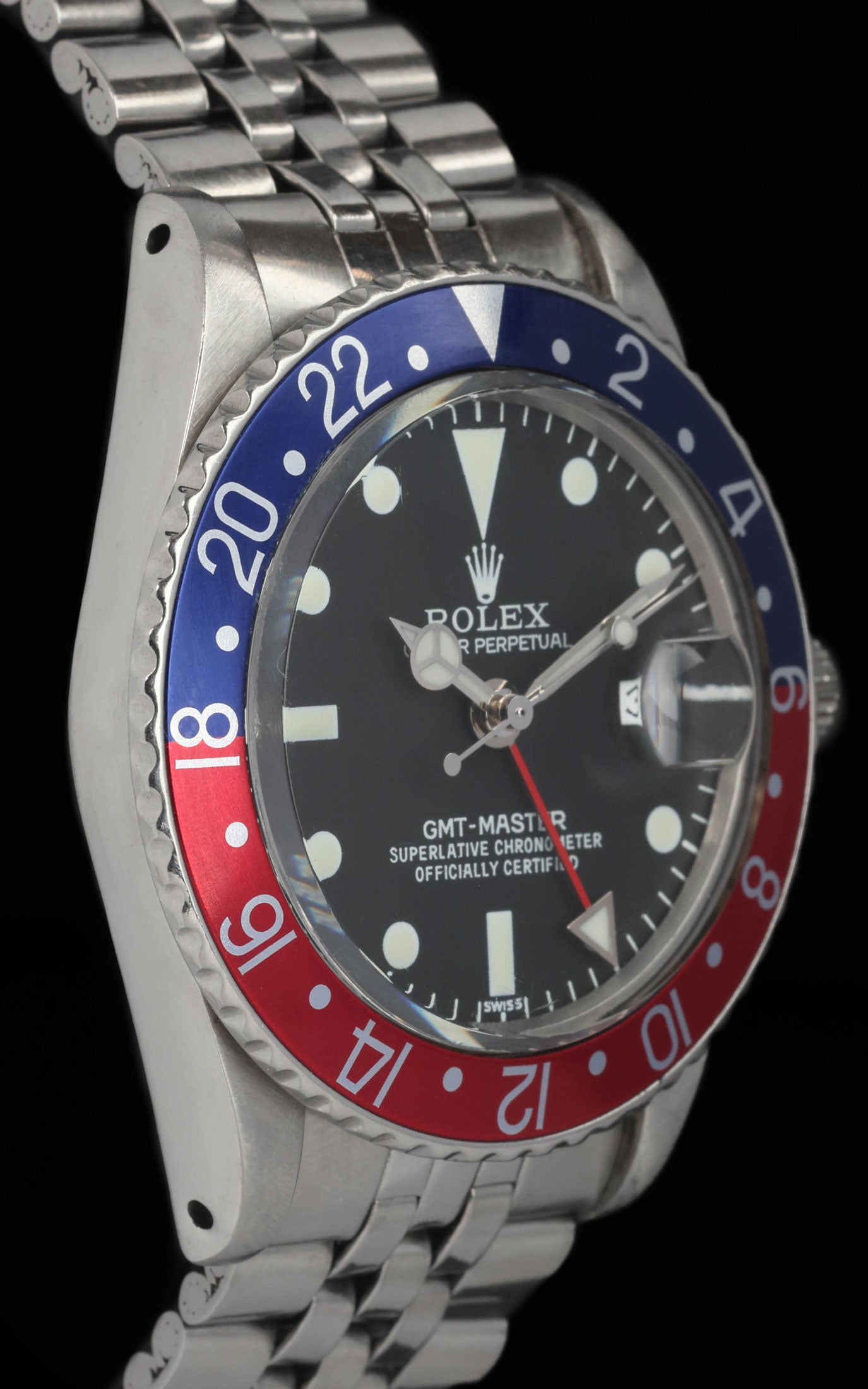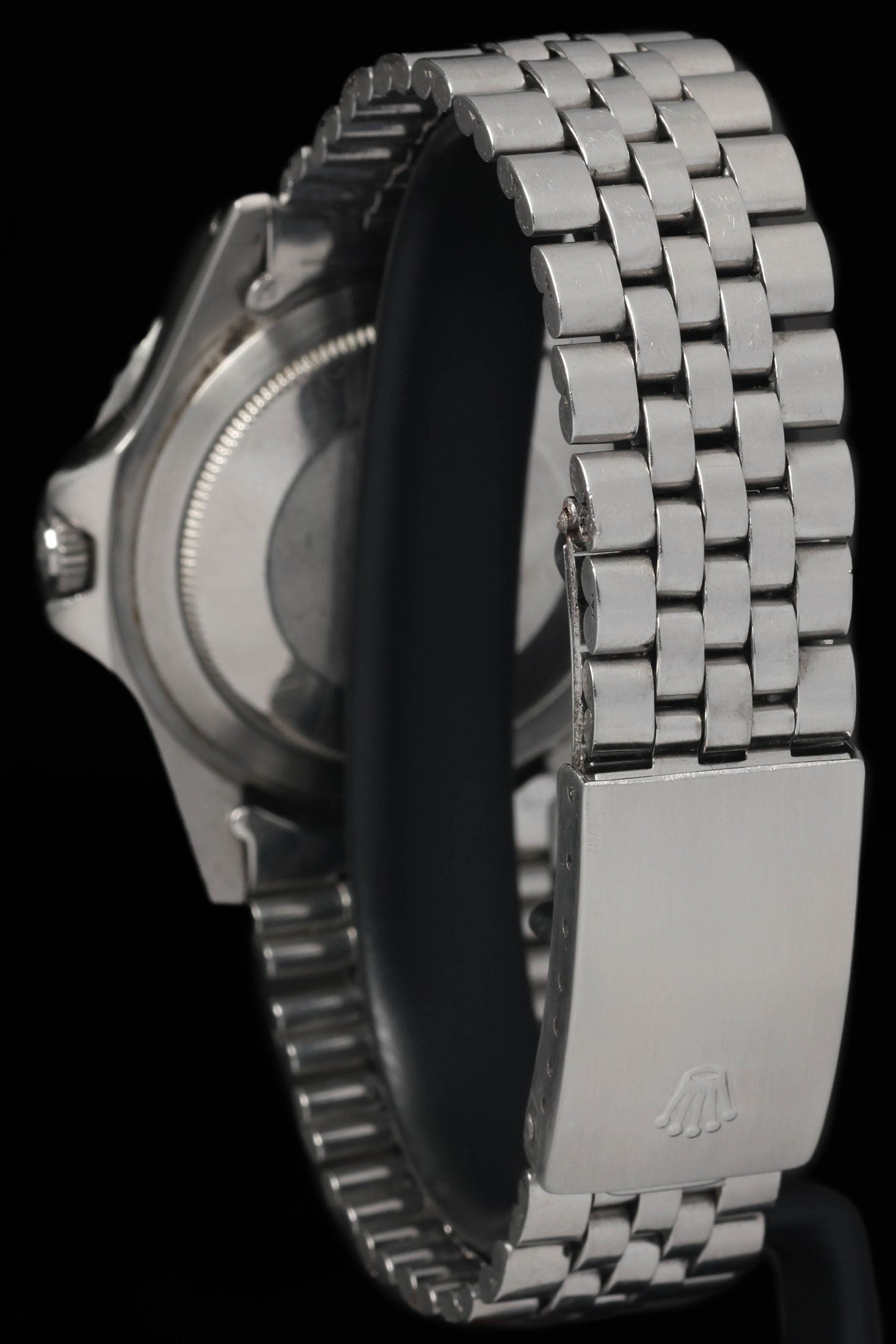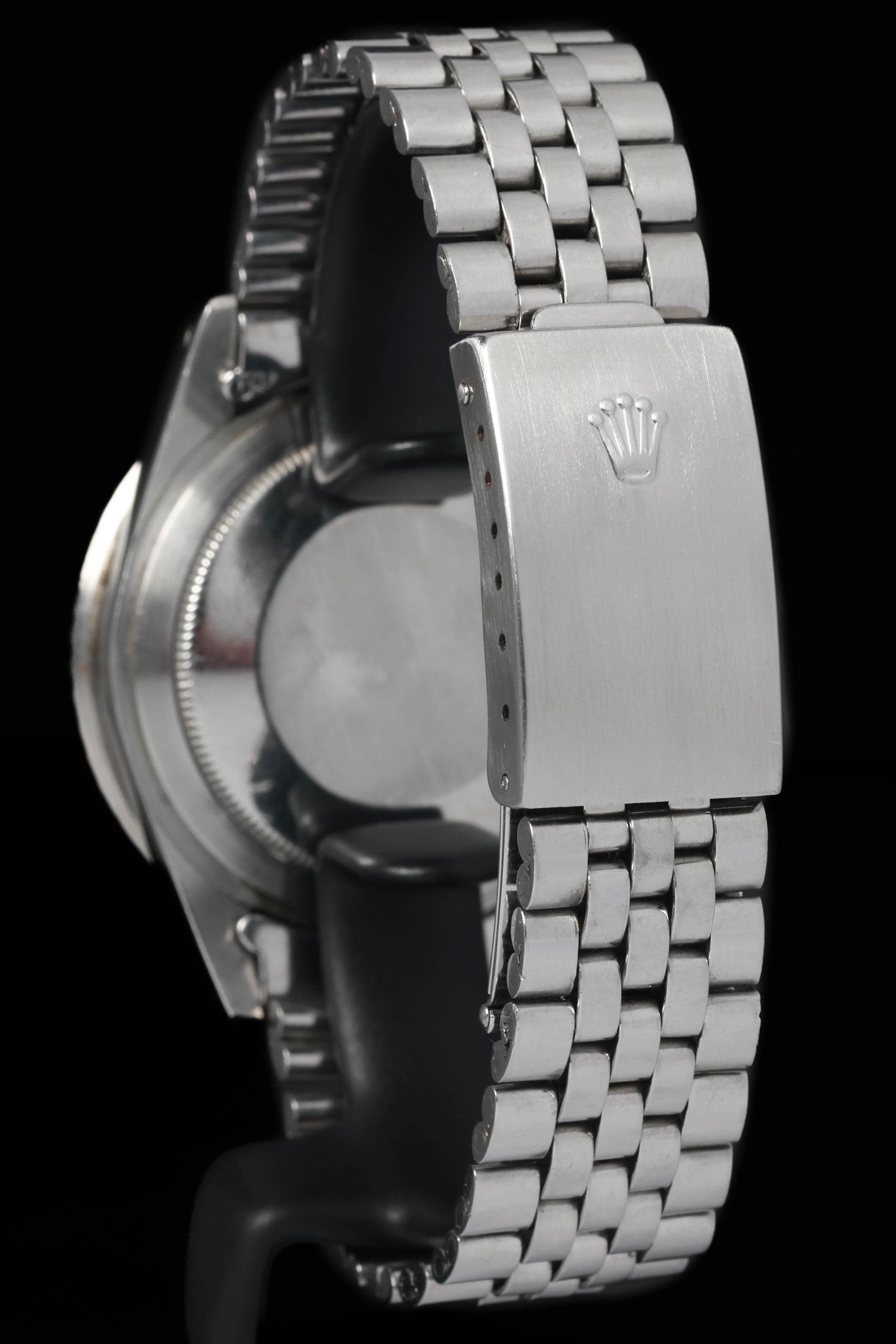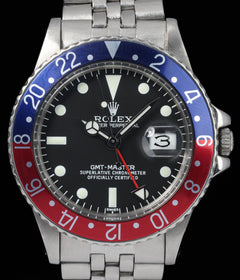Crown Vintage
Rolex GMT Master 1675 'Pepsi' 40MM 1978
Rolex GMT Master 1675 'Pepsi' 40MM 1978
Couldn't load pickup availability
Rolex GMT Master 1675 'Pepsi' 40MM 1978
Case is in great vintage condition, with sharp, well-defined lugs and original factory brushing still visible. The bezel insert retains vibrant red and blue tones, showing light wear consistent with age. Bracelet is a later replacement 6215H Jubilee, exhibiting some stretch but remaining secure and comfortable. Dial and hands are later Rolex service replacements, featuring Luminova luminous material that glows brightly and remains crisp and clean.
The presence of a Rolex service dial, such as the Luminova example on this watch, shifts the collecting lens slightly. They show that the watch was maintained according to Rolex’s official standards, ensuring its continued functionality.
Printing on the dial is sharp, and the hands match well in tone, with no signs of degradation. Overall, this is a strong vintage example of the GMT-Master 1675, combining a well-preserved case with the practicality and legibility of service Luminova dial and hands.
Share
Why we love this watch
Why we love this watch
Rolex GMT-Master 1675 “Pepsi”: A Closer Look at an Icon
Introduction
Produced from around 1959 until 1980, The GMT Master 1675 defined what many now consider the archetype of the GMT-Master: a robust steel tool watch with a colourful bezel, designed for professional pilots yet embraced by travellers and collectors worldwide. While this particular example from 1978 has been fitted with a later Rolex service dial featuring Luminova, the heart of the watch remains unmistakably 1675—an enduring symbol of Rolex’s golden era of tool watch design.
Origins of the GMT-Master
The GMT-Master line was born out of the jet age. In the mid-1950s, Pan American World Airways (Pan Am) approached Rolex to develop a watch capable of displaying two time zones simultaneously, an essential tool for pilots navigating rapidly expanding intercontinental routes. The result was the GMT-Master, introduced in 1955 with the reference 6542. Featuring a bakelite bezel and a fourth 24-hour hand, the watch allowed pilots to read both local and “home” time at a glance.
The fragile bakelite bezel inserts of the 6542, however, proved vulnerable, prompting Rolex to replace them with aluminium. The updated design set the stage for the reference 1675, which would become the longest-running GMT-Master and the model most associated with the iconic red and blue “Pepsi” bezel.
The Long Life of the Reference 1675
Introduced around 1959, the 1675 remained in production for over two decades, undergoing subtle changes but retaining its essential DNA. Its longevity cemented it as one of Rolex’s core sports references, alongside the Submariner and Explorer.
Early 1675s were powered by the calibre 1565, replaced in the mid-1960s by the calibre 1575, which offered improved balance regulation and hacking seconds in later examples. Both movements were robust and chronometer-certified, embodying Rolex’s drive for precision and durability.
Externally, the 1675 featured crown guards—something the 6542 lacked—making it more resilient to knocks and aligning its profile with other Oyster Professional models. Over its long run, dial variants ranged from gilt to matte to later glossy service dials, while bezels and bracelets also evolved, giving collectors today a wide array of sub-variants to study and prize.
The “Pepsi” Bezel
No discussion of the GMT-Master 1675 is complete without mention of the red and blue bezel, nicknamed the “Pepsi” by collectors. The colour scheme was originally chosen for its functionality: red for daylight hours and blue for night, making it easier for pilots to distinguish between day and night time at a glance.
Over the years, these inserts have aged in myriad ways—some fading to pastel shades of sky blue and pink, others turning darker and more subdued. Each watch tells its own story through the bezel’s patina. Aluminium inserts were durable compared with bakelite, yet still prone to fading, scratches, and wear, all of which collectors now celebrate as part of their character.
Dials Through the Decades
The dials of the 1675 evolved dramatically over its life. Early gilt dials with glossy finishes and gold text gave way to matte dials with white printing in the late 1960s, which are now prized for their clarity and vintage aesthetic.
This particular 1978 watch, however, features a service dial fitted during later maintenance at Rolex. The dial is marked by the use of Luminova, the modern luminous compound introduced in the 1990s to replace tritium. Unlike tritium, which develops patina over time and eventually ceases to glow, Luminova maintains its bright white colour and long-lasting luminosity. While some purists prefer untouched original dials with aged tritium, service dials like this one reflect the official Rolex approach to keeping watches functional and legible. In practical terms, it makes the watch more reliable as a daily wearer while still retaining the mechanical and aesthetic foundation of the 1675.
Movements and Functionality
The calibre 1575 inside the GMT-Master 1675 was a proven workhorse, offering automatic winding, chronometer certification, and a hacking seconds function in later production. Unlike later GMT-Master II models, the 1675’s 24-hour hand is geared to the main hour hand and cannot be set independently. To track a second time zone, the bezel must be rotated. For travellers and pilots of the 1960s and 1970s, this was more than sufficient.
It’s worth noting that the simplicity of the calibre 1575 adds to the charm of the 1675. Later models offered more functionality, but the 1675 strikes a balance between utility and elegance.
The Bracelet and Case
Throughout its production, the 1675 was offered on both Oyster and Jubilee bracelets, giving owners a choice between sportier or dressier looks. The Jubilee, with its intricate five-link design, softened the toolish character of the watch, while the Oyster bracelet underscored its rugged professional roots.
The case measured 40 mm, a size that remains modern today. Crown guards evolved in shape during production, moving from pointed to more squared-off designs. The proportions of the case, together with the slim profile of the acrylic crystal, keep the watch elegant on the wrist, unlike the more muscular Submariner cases of later decades.
Cultural Impact
The 1675 is not just a watch but a cultural touchstone. It was worn by figures as varied as astronaut Edgar Mitchell, author Hunter S. Thompson, and countless pilots and travellers of the jet age. Its red and blue bezel became shorthand for adventure, travel, and exploration.
For collectors, the 1675 represents the sweet spot of vintage Rolex: long enough in production to be accessible, yet filled with fascinating variations in dials, bezels, and bracelets. It is simultaneously a tool watch with real-world aviation roots and a design object that has influenced decades of horology.
Service Dials and Collectability
The presence of a Rolex service dial, such as the Luminova example on this watch, shifts the collecting lens slightly. Purists often seek untouched tritium dials, but service dials tell their own story of the watch’s life. They show that the watch was maintained according to Rolex’s official standards, ensuring its continued functionality.
In some ways, a service dial makes the watch more wearable: it glows brightly, resists decay, and has the crisp look of a newer dial. For collectors who value originality above all else, it may reduce perceived rarity, but for those who prize history, condition, and Rolex’s own approach to longevity, it remains a legitimate and important variant in the GMT-Master narrative.
Final Thoughts
The Rolex GMT-Master 1675 “Pepsi” is more than a watch—it is a symbol of the dawn of intercontinental travel, the golden age of Rolex sports models, and the enduring appeal of functional, colourful design. From its origins with Pan Am pilots to its long production run spanning two decades, the 1675 remains a cornerstone for collectors.
This particular example, fitted with a later Luminova service dial, represents Rolex’s philosophy of keeping their watches in service for generations. It retains the character and heritage of the 1675 while offering the practicality of modern luminous material. In this way, it bridges past and present, reminding us why the 1675 remains one of the most beloved and versatile Rolex references ever made.
Case & Bracelet
Case & Bracelet
Case in great vintage condition, sharp defined lugs with brushing still visible. Bracelet is replacement 6215H jubilee with some stretch.
Dial & Hands
Dial & Hands
Dial & hands very good condition.
Warranty & Condition
Warranty & Condition
Crown Vintage Watches provides a minimum 3-month mechanical warranty on pre-owned watches, from the date of purchase.
The warranty covers mechanical defects only.
The warranty does not cover damages such as scratches, finish, crystals, glass, straps (leather, fabric or rubber damage due to wear and tear), damage resulting from wear under conditions exceeding the watch manufacturer’s water resistance limitations, and damage due to physical and or accidental abuse.
Please note, water resistance is neither tested nor guaranteed.
Shipping and insurance costs for warranty returns to us must be covered by the customer. Returns must be shipped via traceable courier. Return shipment must be pre-paid and fully insured. Collect shipping will be refused. In case of loss or damages, the customer is liable.
Our Pledge
At Crown Vintage Watches, we stand by the authenticity of every product we sell. For added peace of mind, customers are welcome to have items independently authenticated at their own expense.
Condition
Due to the nature of vintage timepieces, all watches are sold as is. We will accurately describe the current condition and working order of all watches we sell to the best of our ability.
Shipping & Refund
Shipping & Refund
